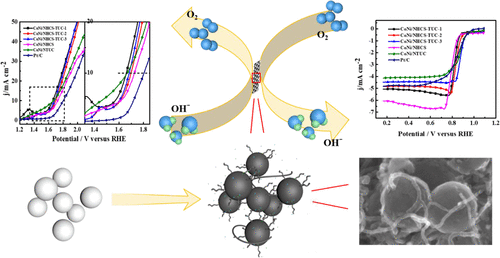当前位置:
X-MOL 学术
›
ACS Appl. Mater. Interfaces
›
论文详情
Our official English website, www.x-mol.net, welcomes your
feedback! (Note: you will need to create a separate account there.)
CoNi Nanoparticles Supported on N-Doped Bifunctional Hollow Carbon Composites as High-Performance ORR/OER Catalysts for Rechargeable Zn–Air Batteries
ACS Applied Materials & Interfaces ( IF 8.3 ) Pub Date : 2021-09-14 , DOI: 10.1021/acsami.1c10671 Kuang Sheng 1 , Qingfeng Yi 1, 2 , A-Ling Chen 1 , Yuebing Wang 1 , Yuhui Yan 1 , Huidong Nie 1 , Xiulin Zhou 1
ACS Applied Materials & Interfaces ( IF 8.3 ) Pub Date : 2021-09-14 , DOI: 10.1021/acsami.1c10671 Kuang Sheng 1 , Qingfeng Yi 1, 2 , A-Ling Chen 1 , Yuebing Wang 1 , Yuhui Yan 1 , Huidong Nie 1 , Xiulin Zhou 1
Affiliation

|
Searching for high-quality air electrode catalysts is the long-term goal for the practical application of Zn–air batteries. Here, a series of coexistent composite materials (CoNi/NHCS-TUC-x) of cobalt–nickel supported on nitrogen-doped hollow spherical carbon and tubular carbon are obtained using a simple pyrolysis strategy. Co and Ni in the composites are mainly present in the form of alloy nanoparticles, M–Nx and M–Cx (M = Co or Ni) species, with high oxygen reduction reaction (ORR)/oxygen evolution reaction (OER) electroactivity. The materials containing different proportions of spherical carbon and tubular carbon obtained by simply adjusting the raw materials for generating tubular carbon exhibit interesting bifunctional performance: samples with an abundant tubular content have the highest ORR onset potential (0.91 V vs reversible hydrogen electrode), while those with a rich spherical content have the highest ORR current density (5.13 mA·cm–2). Furthermore, CoNi/NHCS-TUC-3 provides the lowest potential difference (ΔE = Ej=10 – E1/2) of 0.806 V. We then test the potential possibility of CoNi/NHCS-TUC-3 as an air electrode for primary and rechargeable Zn–air batteries. The primary battery delivers an open-circuit potential of 1.59 V, a peak power density of 361.8 mA·cm–2, and a specific capacity of 756.5 mA h·gZn–1. The rechargeable battery could be cycled stably for more than 55 h at 10 mA·cm–2. These characteristics make CoNi/NHCS-TUC-3 a superior electrocatalyst for both the ORR and OER, as well as a suitable bifunctional electrode applied to a rechargeable Zn–air battery.
中文翻译:

负载在 N 掺杂双功能中空碳复合材料上的 CoNi 纳米颗粒作为可充电锌空气电池的高性能 ORR/OER 催化剂
寻找高质量的空气电极催化剂是锌空气电池实际应用的长期目标。在这里,使用简单的热解策略获得了一系列负载在氮掺杂中空球形碳和管状碳上的钴镍共存复合材料(CoNi/NHCS-TUC- x)。复合材料中的 Co 和 Ni 主要以合金纳米粒子 M-N x和 M-C x 的形式存在(M = Co 或 Ni) 物种,具有高氧还原反应 (ORR)/析氧反应 (OER) 电活性。通过简单调整制备管状碳的原材料获得的含有不同比例的球状碳和管状碳的材料表现出有趣的双功能性能:具有丰富管状含量的样品具有最高的 ORR 起始电位(0.91 V vs 可逆氢电极),而那些具有丰富的球形含量具有最高的 ORR 电流密度 (5.13 mA·cm –2 )。此外,CoNi/NHCS-TUC-3 提供最低的电位差 (Δ E = E j =10 – E 1/2) 0.806 V。然后我们测试了 CoNi/NHCS-TUC-3 作为一次和可充电锌空气电池的空气电极的潜在可能性。原电池的开路电位为1.59 V,峰值功率密度为361.8 mA·cm –2,比容量为756.5 mA h·g Zn –1。可充电电池在10 mA·cm –2 下可稳定循环55 h 以上。这些特性使 CoNi/NHCS-TUC-3 成为 ORR 和 OER 的优异电催化剂,以及适用于可充电锌空气电池的双功能电极。
更新日期:2021-09-29
中文翻译:

负载在 N 掺杂双功能中空碳复合材料上的 CoNi 纳米颗粒作为可充电锌空气电池的高性能 ORR/OER 催化剂
寻找高质量的空气电极催化剂是锌空气电池实际应用的长期目标。在这里,使用简单的热解策略获得了一系列负载在氮掺杂中空球形碳和管状碳上的钴镍共存复合材料(CoNi/NHCS-TUC- x)。复合材料中的 Co 和 Ni 主要以合金纳米粒子 M-N x和 M-C x 的形式存在(M = Co 或 Ni) 物种,具有高氧还原反应 (ORR)/析氧反应 (OER) 电活性。通过简单调整制备管状碳的原材料获得的含有不同比例的球状碳和管状碳的材料表现出有趣的双功能性能:具有丰富管状含量的样品具有最高的 ORR 起始电位(0.91 V vs 可逆氢电极),而那些具有丰富的球形含量具有最高的 ORR 电流密度 (5.13 mA·cm –2 )。此外,CoNi/NHCS-TUC-3 提供最低的电位差 (Δ E = E j =10 – E 1/2) 0.806 V。然后我们测试了 CoNi/NHCS-TUC-3 作为一次和可充电锌空气电池的空气电极的潜在可能性。原电池的开路电位为1.59 V,峰值功率密度为361.8 mA·cm –2,比容量为756.5 mA h·g Zn –1。可充电电池在10 mA·cm –2 下可稳定循环55 h 以上。这些特性使 CoNi/NHCS-TUC-3 成为 ORR 和 OER 的优异电催化剂,以及适用于可充电锌空气电池的双功能电极。











































 京公网安备 11010802027423号
京公网安备 11010802027423号